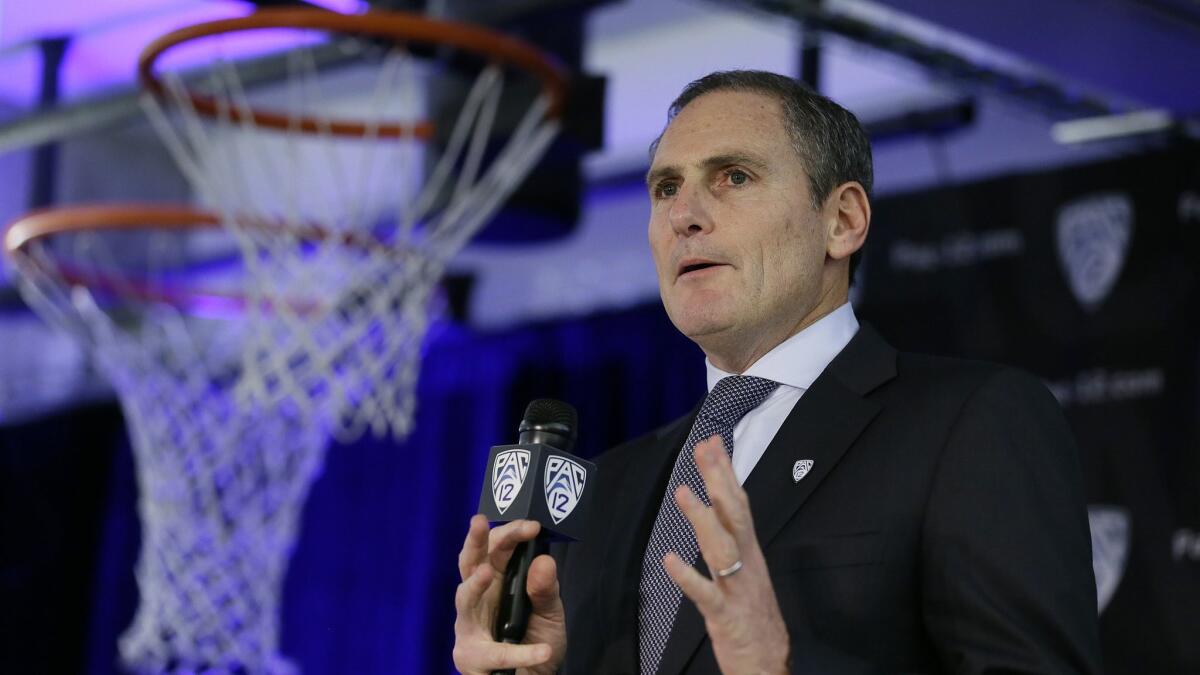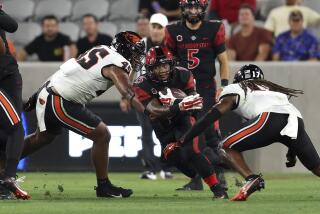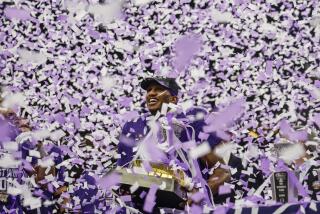Analysis: Struggles in football and basketball aren’t helping Larry Scott’s grand plan for the Pac-12

- Share via
Two words best summarize the Pac-12 Conference’s performance in bowl games this season.
They were uttered by California coach Justin Wilcox after his team stumbled against Texas Christian in the Cheez-It Bowl, a 10-7 overtime loss in which his quarterbacks had five passes intercepted.
“Losing sucks,” Wilcox said.
To be fair, the Pac-12 improved from last season’s embarrassing 1-8 postseason, but not by much.
Fighting for redemption, the conference was favored in the majority of its seven bowl games over the past month. The final tally?
Three wins, four losses, too many doses of dreadful offense.
This is a conference that engaged a high-powered public relations agency in the fall, but positive spin goes only so far if you can’t prevail on the field.
As Utah linebacker Cody Barton said after his team lost to Northwestern in the Holiday Bowl: “We wanted to show those East Coast boys what we’re about … we were on the short end of the stick.”
At the football media day last summer, Pac-12 Commissioner Larry Scott mused about the cyclical nature of winning.
“Much has been written and discussed about our bowl record last year,” he said. “From our perspective, a handful of season-ending games are not a key indicator of a conference’s overall strength and competitiveness.”
Judging the conference by one year might not be fair, but broadening that focus doesn’t help much.
Pac-12 teams have gone 7-15 over the last three bowl seasons. The last time one of its teams won a New Year’s Six game was Jan. 2 2017, when USC defeated Penn State in the Rose Bowl.
The last College Football Playoff victory was in 2015 with Oregon’s semifinal win over Florida State. The favored Ducks subsequently lost to Ohio State in the championship.
The 2018-19 postseason was marked by a distressing lack of firepower.
Washington stalled at three points over three quarters before launching a belated, unsuccessful comeback against Ohio State in the Rose Bowl. Utah built a 20-3 lead in that Holiday Bowl, then went scoreless in the second half, losing 31-20.
Among the winners, Oregon managed only a touchdown in defeating Michigan State 7-6 at the Redbox Bowl and Stanford needed a late score to get past Pittsburgh 14-13 in the Sun Bowl.
Football isn’t the only sport that has suffered.
Conference schools endured a tough December in men’s basketball. Not a single team remains in the Associated Press Top 25, and the flagship UCLA program is searching for a coach after firing Steve Alford at midseason.
Like most discussions about big-time college sports, the Pac-12 debate inevitably turns to the subject of money.
While other Power Five conferences were launching networks in partnership with established broadcasters such as ESPN and Fox, making deals that brought immediate paydays, Scott convinced his schools to gamble on their own television venture.
The Pac-12 Networks have struggled to build viewership, in part because they cannot reach an agreement with DirecTV.
This helps explain why the conference ranks down the list in overall revenue distribution, with its schools receiving about $30 million as compared to the $40 million-plus payouts in the Southeastern Conference, according to information contained in tax returns.
There is a direct connection to on-the-field performance, with athletic departments having less money to sign the coaches and build the facilities that lure top recruits.
Still, Scott has continued to argue for his strategy. Outside networks might ignore such sports as volleyball and water polo, he says. They might push every football and men’s basketball game to a nighttime start, too late for viewers in other parts of the country.
But scheduling is already problematic because the Pac-12 signed a 12-year, $3-billion side deal that diverts many of its best games to those outsiders.
Asking for patience, Scott says the conference will close the financial gap no later than 2024, when the side deal comes up for renegotiation.
The question is, how much longer can his football and men’s basketball teams wait?
When does the financial shortfall trickle down to those Olympic sports the so-called “Conference of Champions” often boasts about?
Another gloomy season has turned up the heat on the commissioner. There was an instant-replay scandal — which coincided with conference officials hiring the FleishmanHillard public relations agency — followed by the bowl results.
If Scott were a big-time football or basketball coach, it would be hard to imagine him surviving in his job.
And Washington coach Chris Petersen could have been speaking for the entire conference when he assessed his football program after the Rose Bowl loss.
“Well, I think it means we’re close to being where we want to be,” he said. “But we’re not there.”
Follow @LAtimesWharton on Twitter
More to Read
Go beyond the scoreboard
Get the latest on L.A.'s teams in the daily Sports Report newsletter.
You may occasionally receive promotional content from the Los Angeles Times.











